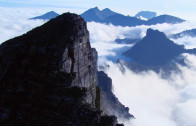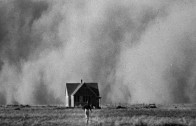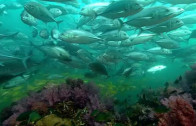Planet Earth
Planet Earth is a comprehensive series of eleven episodes that each feature a global overview of a different biome or habitat on Earth.
Series
The first episode illustrates a journey around the globe, revealing the effect of gradual climate change and seasonal transitions en route. During Antarctica’s winter, emperor penguins endure four months of darkness, with no food, in temperatures of -70°C (−94°F). Meanwhile, as spring arrives in the Arctic, polar bear cubs take their first steps into a world of rapidly thawing ice. In northern Canada, the longest overland migration of any animal–over 3,200 kilometres (2,000 mi)–is that of three million caribou, which are hunted by wolves, and one such pursuit is shown. The forests of eastern Russia are home to the Amur leopard; with a population of just 40 individuals in the wild, it is now the world’s rarest cat. Other species shown include New Guinea’s birds of paradise, African hunting dogs in their efficient pursuit of impala, elephants in Africa migrating towards the waters of the Okavango Delta, a seasonal bloom of life in the otherwise arid Kalahari Desert, and 300,000 migrating Baikal teal, containing the world’s entire population of the species in one flock.
Part two focuses on the mountains. All the main ranges are explored with extensive aerial photography. Ethiopia’s Erta Ale is the longest continually erupting volcano for over 100 years. On the nearby highlands, geladas (the only primate whose diet is almost entirely of grass) inhabit precipitous slopes nearly five kilometres (3 mi) up, in troops that are 800-strong: the most numerous of their kind. Alongside them live the critically endangered walia ibex, and both species take turns to act as lookout for predatory Ethiopian wolves. The Andes have the most volatile weather and guanacos are shown enduring a flash blizzard, along with an exceptional group sighting of the normally solitary puma. The Alpine summits are always snow-covered, apart from that of the Matterhorn, which is too sheer to allow it to settle. Grizzly bear cubs emerge from their den for the first time in the Rockies, while Himalayan inhabitants include rutting markhor, golden eagles that hunt migrating demoiselle cranes, and the rare snow leopard. At the eastern end of the range, the giant panda cannot hibernate due to its poor nutriment of bamboo and one of them cradles its week-old cub. Also shown is the Earth’s biggest mountain glacier: the Baltoro in Pakistan, which is 70 kilometres (43 mi) long and visible from space.
The fresh water programme describes the course taken by rivers and some of the species that take advantage of such a habitat. Only 3% of the world’s water is fresh, yet all life on land is ultimately dependent on it. Its journey begins as a stream in the mountains, illustrated by Venezuela’s Tepui, where there is a tropical downpour almost every day. It then travels hundreds of kilometres before forming rapids. With the aid of some expansive helicopter photography, one sequence demonstrates the vastness of Angel Falls, the world’s highest free-flowing waterfall. Its waters drop unbroken for nearly 1,000 metres (3,000 feet) and are blown away as a mist before they reach the bottom. In Japan, the water is inhabited by the biggest amphibian, the two-metre long giant salamander, while in the northern hemisphere, salmon undertake the largest freshwater migration, and are hunted en route by grizzly bears. The erosive nature of rivers is shown by the Grand Canyon, created over five million years by the Colorado River. Also featured are smooth coated otters repelling mugger crocodiles and the latter’s Nile cousin ambushing wildebeest as they cross the Mara River. Roseate spoonbills are numerous in the Pantanal and are prey to spectacled caiman. In addition, there are cichlids, piranhas, river dolphins and swimming crab-eating macaques.
This episode explores caves. At a depth of 400 metres (1,300 ft), Mexico’s Cave of Swallows is Earth’s deepest pit cave freefall drop, allowing entry by BASE jumpers. Its volume could contain New York City’s Empire State Building. Also explored is the otherworldly cenotes of the Yucatán Peninsula. Divers appeared to be flying in water as clear as in air, as they give us a glimpse of the hundreds of kilometers of these caves which have already been mapped. Also featured is Borneo’s Deer Cave and Gomantong Cave. Inhabitants of the former include three million wrinkle-lipped bats, which have deposited guano on to an enormous mound. In Gomantong Cave, guano is many metres high and is blanketed with hundreds of thousands of cockroaches and other invertebrates. Also depicted are eyeless, subterranean creatures, such as the Texas blind salamander and a species of crab. Carlsbad Caverns National Park is featured with its calcite formations. Mexico’s Cueva de Villa Luz is also featured, with its flowing stream of sulphuric acid and snottite formations made of living bacteria. A fish species, the shortfin molly, has adapted to this habitat. The programme ends in New Mexico’s Lechuguilla Cave (discovered in 1986) where sulphuric acid has produced unusually ornate, gypsum crystal formations.
This instalment features the harsh environment that covers one third of the land on Earth: the deserts. Due to Siberian winds, Mongolia’s Gobi Desert reaches extremes of temperature like no other, ranging from -40°C to +50°C (-40°F to 122°F). It is home to the rare Bactrian camel, which eats snow to maintain its fluid level and must limit itself to 10 litres (2.6 U.S. gal; 2.2 imp gal) a day if it is not to prove fatal. Africa’s Sahara is the size of the USA, and just one of its severe dust storms could cover the whole of Great Britain. While some creatures, such as the dromedary, take them in their stride, for others the only escape from such bombardments is to bury themselves in the sand. Few rocks can resist them either and the outcrops shown in Egypt’s White Desert are being inexorably eroded. The biggest dunes (300 m or 1,000 ft high) are to be found in Namibia, while other deserts featured are Death Valley in California and Nevada, the Sonoran in Arizona, the deserts of Utah, all in the United States, the Atacama in Chile, and areas of the Australian outback. Animals are shown searching for food and surviving in such an unforgiving habitat: African elephants that walk up to 80 kilometres (50 mi) per day to find food; lions (hunting oryx); red kangaroos (which moisten their forelegs with saliva to keep cool); nocturnal fennec foxes, acrobatic flat lizards feeding on black flies, and duelling Nubian ibex.
The sixth programme looks at the regions of the Arctic and Antarctica. The latter contains 90% of the world’s ice, and stays largely deserted until the spring, when visitors arrive to harvest its waters. Snow petrels take their place on nunataks and begin to court, but are preyed on by South Polar skuas. During summer, a pod of humpback whales hunt krill by creating a spiralling net of bubbles. The onset of winter sees the journey of emperor penguins to their breeding grounds, 160 kilometres (99 mi) inland. Their eggs transferred to the males for safekeeping, the females return to the ocean while their partners huddle into large groups to endure the extreme cold. At the northern end of the planet, Arctic residents include musk oxen, who are hunted by Arctic foxes and wolves. A female polar bear and her two cubs head off across the ice to look for food. As the sun melts the ice, a glimpse of the Earth’s potential future reveals a male polar bear that is unable to find a firm footing anywhere and has to resort to swimming–which it cannot do indefinitely. Its desperate need to eat brings it to a colony of walrus. Although it attacks repeatedly, the herd is successful in evading it by returning to the sea. Wounded and unable to feed, the bear will not survive. Meanwhile, back in Antarctica, the eggs of the emperor penguins finally hatch.
This episode deals with savanna, steppe, tundra, prairie, and looks at the importance and resilience of grasses in such treeless ecosystems. Their vast expanses contain the largest concentration of animal life. Over Africa’s savanna, a swarm of 1.5 billion Red-billed Queleas are caught on camera, the largest flock of birds ever depicted.[32] In Outer Mongolia, a herd of Mongolian gazelle flee a bush fire and has to move on to new grazing, but grass can repair itself rapidly and soon reappears. On the Arctic tundra during spring, millions of migratory snow geese arrive to breed and their young are preyed on by Arctic foxes. Meanwhile, time-lapse photography depicts moving herds of caribou as a calf is brought down by a chasing wolf. On the North American prairie, bison engage in the ritual to establish the dominant males. The Tibetan Plateau is the highest of the plains and despite its relative lack of grass, animals do survive there, including yak and wild ass. However, the area’s most numerous resident is the pika, whose nemesis is the Tibetan fox. In tropical India, the tall grasses hide some of the largest creatures and also the smallest, such as the pygmy hog. The final sequence depicts African bush elephants that are forced to share a waterhole with a pride of thirty lions. The insufficient water makes it an uneasy alliance and the latter gain the upper hand during the night when their hunger drives them to hunt and eventually kill one of the pachyderms.
This episode examines jungles and tropical rainforests. These environments occupy only 3% of the land yet are home to over half of the world’s species. New Guinea is inhabited by almost 40 kinds of birds of paradise, which avoid conflict with each other by living in different parts of the island. Some of their elaborate courtship displays are shown. Within the dense forest canopy, sunlight is prized, and the death of a tree triggers a race by saplings to fill the vacant space. Figs are a widespread and popular food, and as many as 44 types of bird and monkey have been observed picking from a single tree. The sounds of the jungle throughout the day are explored, from the early morning calls of siamangs and orangutans to the nocturnal cacophony of courting tree frogs. The importance of fungi to the rainforest is illustrated by a sequence of them fruiting, including a parasite called cordyceps. The mutual benefits of the relationship between carnivorous pitcher plants and red crab spiders is also discussed. In the Congo, roaming forest elephants are shown reaching a clearing to feed on essential clay minerals within the mud. Finally, chimpanzees are one of the few jungle animals able to traverse both the forest floor and the canopy in search of food. In Uganda, members of a 150-strong community of the primates mount a raid into neighbouring territory in order to gain control of it.
This programme is devoted to the shallow seas that fringe the world’s continents. Although they constitute 8% of the oceans, they contain most marine life. As humpback whales return to breeding grounds in the tropics, a mother and its calf are followed. While the latter takes in up to 500 litres of milk a day, its parent will starve until it travels back to the poles to feed — and it must do this while it still has sufficient energy left for the journey. The coral reefs of Indonesia are home to the biggest variety of ocean dwellers. Examples include banded sea kraits, which ally themselves with goatfish and trevally in order to hunt. In Western Australia, dolphins ‘hydroplane’ in the shallowest waters to catch a meal, while in Bahrain, 100,000 Socotra cormorants rely on shamals that blow sand grains into the nearby Persian Gulf, transforming it into a rich fishing ground. The appearance of algae in the spring starts a food chain that leads to an abundant harvest, and sea lions and dusky dolphins are among those taking advantage of it. In Southern Africa, as chokka squid are preyed on by short-tail stingray, the Cape fur seals that share the waters are hunted by the world’s largest predatory fish: the great white shark. On Marion Island in the Indian Ocean, a group of king penguins must cross a beach occupied by fur seals that do not hesitate to attack them.
Part ten surveys the coniferous and deciduous seasonal woodland habitats–the most extensive forests on Earth. Conifers begin sparsely in the subarctic but soon dominate the land, and the taiga circles the globe, containing a third of all the Earth’s trees. Few creatures can survive the Arctic climate all year round, but the moose and wolverine are exceptions. 1,600 kilometres (990 mi) to the south, on the Pacific coast of North America, conifers have reached their full potential. These include some of the world’s tallest trees: the redwoods. Here, a pine marten is shown stalking a squirrel, and great grey owl chicks take their first flight. Further south still, in the Valdivian forests of Chile, a population of smaller animals exist, including the pudú and the kodkod. During spring in a European broad-leafed forest, a mandarin duck leads its day-old family to leap from its tree trunk nest to the leaf litter below. Bialowieza Forest typifies the habitat that characterised Europe around 6000 years ago: only a fragment remains in Poland and Belarus. On a summer night on North America’s east coast, periodical cicadas emerge en masse to mate–an event that occurs every seventeen years. After revisiting Russia’s Amur leopards in winter, a timelapse sequence illustrates the effect of the ensuing spring on the deciduous forest floor. In India’s teak forests, a langur monkey strays too far from the chital that act as its sentinels and falls prey to a tiger. In Madagascar, mouse lemurs feed on the nectar of flowering baobab trees.
The final episode concentrates on the least explored area of the planet: the deep ocean. It begins with a whale shark used as a shield by a shoal of bait fish to protect themselves from yellowfin tuna. Also shown is an oceanic whitetip shark trailing rainbow runners. Meanwhile, a 500-strong school of dolphins head for the Azores, where they work together to feast on scad mackerel along with a shearwater flock. Down in the ocean’s furthest reaches, some creatures defy classification. On the sea floor, scavengers such as the spider crab bide their time, awaiting carrion from above. The volcanic mountain chain at the bottom of the Atlantic Ocean also sustains life through the bacteria that surround its sulphide vents. There are thought to be around 30,000 undersea volcanoes, some of them taller than Mount Everest. Their sheer cliffs provide anchorage for several corals and sponges. Nearer the surface, the currents that surround these seamounts force nutrients up from below and thus marine life around them is abundant. Ascension Island is a nesting ground for frigatebirds and green turtles. Off the Mexican coast, a large group of sailfish feed on another shoal of bait fish, changing colour to signal their intentions to each other, allowing them to coordinate their attack. The last sequence depicts the largest animal on Earth: the blue whale, of which 300,000 once roamed the world’s oceans. Now fewer than 3% remain.




